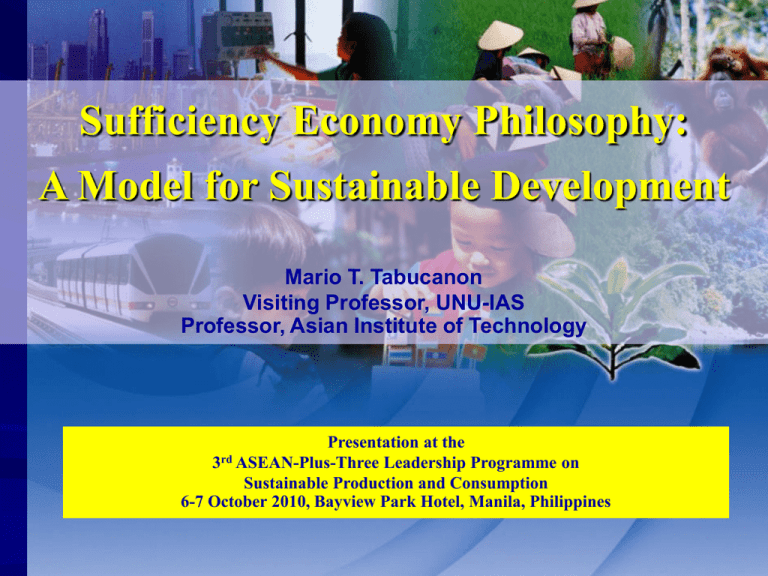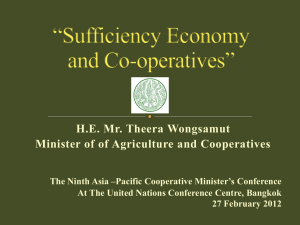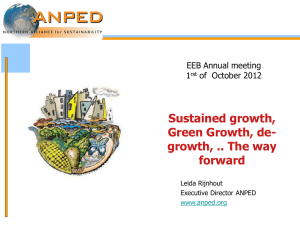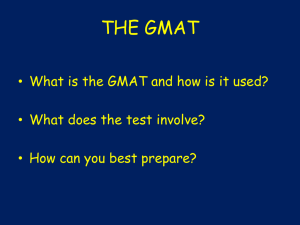
Sufficiency Economy Philosophy:
A Model for Sustainable Development
Mario T. Tabucanon
Visiting Professor, UNU-IAS
Professor, Asian Institute of Technology
Presentation at the
3rd ASEAN-Plus-Three Leadership Programme on
Sustainable Production and Consumption
6-7 October 2010, Bayview Park Hotel, Manila, Philippines
The Sufficiency Economy
Philosophy (SEP)
His Majesty, the King of Thailand
developed SEP
HM introduced SEP in all Royal
Projects in Thailand (Since 1974)
SEP is a model for achieving SD
SEP is the overarching principle in the
9th and current (10th) Thailand National
Economic and Social Development
Plans, 2001-2006 & 2007-2012
Philosophy of “Sufficiency
Economy”
“Sufficiency Economy” is a
philosophy that stresses the
middle path as an overriding
principle for appropriate
conduct at all levels of society -.
individuals, households, community,
organizations or government
•1992: During economic boom, HM
warned against hastily jumping
into the wind of “Asian NICs”
and “Asian Tigers.”.
•1997: Indeed, Thailand suffered
during the Asian financial crisis.
But due in part to the application of
”
SEP, Thailand had recovered relatively
fast.
•Although His Majesty has been talking
about sufficiency economy since 1974, it
was only in 1997 at the height of the
financial crisis that HM began to use
the term “Sufficiency Economy”.
Components of SEP
“Sufficiency has three
components: moderation;
reasonableness; and the need
for built-in resilience against
the risks which arise from
unwanted internal or external
change.”
Main Components of Sufficiency
Economy
(1) Moderation
Sufficiency
Economy
(2) Reasonableness
(3) Self-Immunity
Conditions: SEP Will work best if there is
(1) Application of appropriate knowledge and prudence
(2) Adherence to morality
Middle Path
Moderation
Reasonable
ness
Knowledge
Resiliency
Morality
Balance
Security
Sustainability
Frameworks of the 9th & 10th Plans
HM King’s Philosophy of "Sufficiency Economy”
The Middle Path
Moderation
Reasonableness
Wisdom Condition
(an application of knowledge
with due consideration and
prudence )
Leading to
“Immune”
System
Moral Condition
(honesty, integrity, diligence,
patience, perseverance)
ชีวิต/เศรษฐกิจ/สังคม
Life/Economic/Social
สมด ุล/มัน่ คง/ยัง่ ยืน
Balance/Stable/Sustainable
GLOBAL
KNOWLEDGE POOL
EXPLODED & CONNECTED
Ethical Values
governing
TECHNOLOGY ASSESSMENT
SUSTAINABILITY
KNOWLEDGE ACCESS
KNOWLEDGE VALIDATION
KNOWLEDGE VALUATION
KNOWLEDGE-BASED
DEVELOPMENT &
PROBLEM-SOLVING
CONTEXT, SITUATION, LOCATION,
& TIME DEPENDENT
Discoveries & Innovations
Patents & monopoly
Pricing of technology
Needs for technology
Limited resources
POORER
IMMUNITY ?
“Uneducated person can do petty corruption,
Educated can do deliberate ones”.
PROHIBITIONS
1. Dishonesty, plagiarism
2. Academic lie
New Ethics
eg. brain death, GMO, stem cells, global warming,
democracy, corporate social responsibility
SUSTAINABILITY
Natural resources
Environment
Consumption
Production
How does SE relate to Neoclassical
Economics?
Y
Max
S (1+r)-t E[U(C,..,t)]
Subject to Budget Constraints
Optimality
A
Preference
X
How does SE relate to Neoclassical
Economics?
Y
“Satisfice” S
(1+r)-t E[U(C,..,t)]
Subject to Budget Constraints
Middle path solution
A
Preference
X
Difference between SE and Neoclassical
Economics
Neoclassical Economics
Optimality
• Depend on Preference,
and Constraints to
Maximize Utility
Sufficiency Economy
Middle path
• Choose middle path
based on moderation,
reasonableness and
self-immunities –
“Bounded Rationality” or
“Satisficing”
Applications of Neoclassical Economics
Neoclassical economics tries to understand human choices and
explains the observed pattern using the optimizing framework
Risk Loving
Social Status
Lack of Self Discipline
Addiction
Short-sighted
Envy
Human behavior
Risk Averse
Long-sighted
Prudence
Prudent
Person
SE and Human Behavior
Prudent Person
(1) Moderation
(2) Reasonableness
(3) Self-Immunity
The behavior of those who adhere to SEP will be similar to the behavior of “prudent
persons”.
Misconceptions concerning SEP
1. Sufficiency Economy is about selfsufficiency: This is a misconception.
SE concept entails a two-stage
process: the first stage involves basic
sufficiency, or relative selfsufficiency, and once a firm
foundation is established, one can
progress to a second stage of
advanced sufficiency.
Misconception
2. Sufficiency Economy is anti-globalization
and leads to the closing-up of the
economy: This is a misconception
The two-stage principle of Sufficiency
Economy suggests that in order to cope
with globalization, we first need to build a
strong foundation for the country and
proceed cautiously with an awareness of
the risks involved.
SEP strategic framework for a
country in the globalization era
Build a strong domestic economy and
improve networking at all levels (local,
national & global)
Liberalization of key sectors has to be
carried out in steps and to be consistent with
the country’s state of readiness
Proper supply-side management policy to
help withstand the shocks and volatility
arising from external factors
Misconception
3. That ‘Economy’ in the term
‘Sufficiency Economy’ only refers to
the conventional concept of
‘Economics’. This is a misconception.
‘Economy’ in SE encompasses the
triple bottom line – Economics, Social
& Way of Life, and Environmental.
Misconception
4. Sufficiency Economy is only
applicable in the agricultural sector and
rural areas: This is a misconception
Sufficiency Economy is a philosophy
that helps guide the behavior of each
individual and can be applied to all
sectors of the economy
Applications of Sufficiency Economy Philosophy
Sufficiency Economy
1. Daily life
- Moderation
- Reasonableness
- Self-immunity
2. Economic Development
- Agricultural/Community Development
- Business Practices
- Government Policies
SEP Applications to Daily Life
As guiding principle in daily activities:
Especially in answering questions such
as : How should we act?
Which items should we buy?
How should we live our lives?
Together, the answers to these questions
will help define what it means to “live
according to a sufficiency lifestyle”.
Example: Buying a House
If we try to follow SEP, then we have to
ask ourselves at least three questions:
First, whether this house is a suitably
moderate choice, given limited
resources.
Second, whether it is a reasonable
thing to do to buy a large house just to
show it off occasionally to our friends.
Third, whether the financing of this
particular house will leave the buyer
vulnerable to adverse effects that might
happen in the future.
AVOID EXCESSIVE OVERCONSUMPTION BEHAVIORS
UNNECESSARY DESIRE
NATURAL DESIRE
Longest life
Youthfulness
Beauty
Ease of living
Enjoyment
Recreation
etc.
Anti-oxidant food supplements/ potions/ drugs
Cosmetic surgery
Addictions: drugs, non-drugs, sugar, lifestyles
Satiety for violence, sex, extremes
KNOWLEDGE & WISDOM
For Rational Decision
NECESSITIES
IN LIFE
Food
Energy
Water
Transportation
Communication
Housing
etc.
IMMUNITY
against seduction
& addiction
‘AFFLUEZA’
ELECTRICITY, FOSSIL FUEL, PETROLEUM
INFRASTRUCTURES
OBESITY
OBESITY
In Thailand, up to 30% of adults and adolescents
reached “obese” range.
From 1986 to 2008, the situations were getting worse.
Change of food habits from rice, vegetables and fruits
to Western style of food – food of high fat, protein & sugar
MOTIVATION
Public
Prohibition of sale
Exercise Programs of junk food in schools.
Soaring sale of “food supplements” claimed to control weight.
Advertisement, promotion & direct sale
Booming of spa and exercise businesses
SUFFICIENCY ECONOMY
Individuals: resisting me-too temptation
Society: virtue of saving,
shame for showing off luxuries.
DESIRE-BASED TRADE
BEAUTY
BUSINESSES
Cosmetics
AGEING
Health
YOUTHFULNESS
RECREATION
Health food
IMMORTALITY
Spa
Exercise
GAMBLING
EXCITEMENT Weight control
Sport
Lottery
Advertisement, Sale Promotion
SELF CONTROL OF DESIRE
Restraint against profit from desire-based trade
Spiritual Dimension of SEP
“If one is moderate in one’s desires, one will
have less craving. If one has less craving,
one will take less advantage of others.
…Sufficiency means to have enough to live
on. Sufficiency means to lead a reasonably
comfortable life, without excess, or
overindulgence in luxury, but enough….”
(Royal Speech, given at Dusit Palace, 4
December 1998)
Agricultural and Community
Development
Thai agriculture in the recent past - Monoculture
- Problems from
Monoculture
- Problems from
Supply/Demand
Adjustment
- Weather
- Debt Problem
- Migration and
weakness of the
villages
New Theory of Agriculture
Emphasizes diversified farming
techniques and the need to develop the
communities, stage by stage, by laying
down a firm foundation first.
New Theory for Agriculture
1. First step The aim is to let the farmers be
able to support themselves (self-sufficiency)
especially concerning rice. If the main problem
is water then they should dig a pond in their land
to make sure that they have enough water for
farming and household usages which they might
need support from the government or private
sector in digging the pond. (30% water, 30%
rice, 30% vegetables/fruits/livestock, and 10%
house of the total area)
New Theory
2. Second step Farmers should
work together and create a
cooperative to reduce the cost of
production and for saving
purposes as well as social security
and together they will also have
more negotiating power in selling
their products to the markets.
New Theory
3. Third step For developed
communities, further expansion of
the production process and
commerce such as cooperative
stores or rice milling factories can
rely further from the cooperation
from commercial banks in
improving their livelihood.
Procedure of the New Theory
1st phase: Implementation / Production
Advising/
Experimenting
Getting
results
Implementing
Support
from
outside
2nd phase: Expansion / Marketing
Better living
conditions
Production / Marketing
Joining
forces
Support
from
outside
3rd phase: Advancement / Processing /
Adding Value
Cooperation/
Capital
Quality of life
Sustainable
development
Support
from
outside
Benefits of the New Theory
Steady and higher income margin
Agriculture in
accordance
with
the New Theory
Advice, consultations:
Farmer-farmer
Official- farmer
Farmers and
their children
have better
education
opportunities
Better learning/
education
Knowledge and
learning on the job
Monitoring of news
and information on
farming practices
Farm Families and Communities: Socio-economic
Impact
Job available the
whole year round
Work in the locality
Diverse activities,
perennial trees,
fruits, vegetables,
livestock
Family members joining activities,
spending more time together,
taking good care of children and
the elderly
More frequent harvests
Steady and higher income margin
Strengthened Community
Diverse activities,
perennial trees,
fruit trees,
vegetables,
livestock
Members of
working age
are kept in
the locality
Working force is available for community work
and other communal work in the rice fields and
plantations
Different
harvest
times
Steady incomes
Higher incomes
Equitable
distribution
of income
Increased
and
diverse
production
Resources in
the rice fields
are better
utilized in turn
Sufficient
food
Strengthened
community
Organizing as groups
Or cooperatives for
production, marketing,
welfare
Dependence on outside sources
is reduced
Business Practices
For the Corporate Sector SEP
suggests
Greater emphasis on:
good risk management,
well thought-out business plans,
sustainable investment,
good corporate governance,
good corporate citizenship in terms of
taking on corporate social
responsibilities (CSR).
Siam Cement Case
Decided to adopt SEP as its
guiding principle. It restructured
and refocused its activities on its
core business, where it has strong
competitiveness, and put more
emphasis on risk management to
build greater resiliency.
Siam Cement Case
It now gives priority to its human
resource development program to build
a quality workforce that will provide the
firm with greater immunity to future
uncertainty;
It also engages in a wide range of
corporate social responsibility
activities such as community
development and environmental
protection, as well as supporting other
social causes.
Examples (Applying Immunity)
• Thinking about others
Saha Farm
• Self immunity
Hana
- Prudence and not too greedy
• Thinking about staffs
• Cautious expansion
Pricing moderately
Do not borrow
unnecessarily
Seven Eleven
Empathy to
your staffs
Golden Place
Building your
foundation
Pantasen, A et al: Application of Sufficiency Economy to Small and
Medium-sized Industries, a survey of 296 enterprises, 2003
Sufficiency
Economy
Indicators
6 groups
of
Industries
90% felt that “Sufficiency Economy” could be applied to their enterprises.
Production plan in line with their ability to manage,
Honesty to customers and social responsibility
Risk taking and outside financing
is difficult to avoid for medium-sized ones
Government Policies
Implications of SEP on Government
Policies
1. Macroeconomic
Management
2. Government Policy Design
3. Alternative Development Strategy
Implications of SEP on Government Policies
Moderation
1. Macro
Management
Reasonableness
Mega-project, Growth,
Inflation, Budget Deficit
Self- immunity
Adequate Saving
Energy Security
National Risk Manag..
2. Gov. Policy
Design
Design of governmental projects to make people to be more sufficient
(Village funds, Debt ‘forgiveness’, Education reform etc.)
3. Alternative
Development
Strategy
Balanced economic development framework
Rural along side with Industrial development; Strong communities;
Quality growth; No need to go fast; Emphasis on public well-being
Regulations & Standards
Infrastructures: services
transportation
water
energy
waste management
recycling facilities
Pricing, Taxes, Choices, Sanction
SEP as an Approach to Sustainable
Development
The SEP path of development
emphasizes a balanced use of
material resources,
social capital,
environmental reserves, and
cultural wealth
as well as the balanced preservation of
these four kinds of resources at all
stages and levels of development.
SEP and SD
There are two distinct
characteristics of the SEP
approach to development:
a consideration of society and of
culture.
SEP and SD
The National Human Development
Report 2007 – ‘Sufficiency Economy
and Human Development in Thailand’
-- has come up with six key messages
for future action.
1. Sufficiency Economy is central to
alleviating poverty and reducing the
economic vulnerability of the poor.
2. Sufficiency Economy is a means
towards community empowerment
and the strengthening of communities
as foundations of local economies
SEP and SD
3. Sufficiency Economy takes corporate
responsibility to a new level by raising
the strength of commitment to
practices conducive to long-term
profitability in a competitive
environment.
4. Sufficiency principles are vital for
improving standards of governance in
public administration.
SEP and SD
5. Sufficiency Economy can guide
national policy to immunize a country
against shocks, to craft better policies,
and to plan strategies for more
equitable and sustainable growth.
6. Sufficiency thinking demands a
transformation of human values, a
revolution in the mindset, necessary for
the advancement of human
development.
EDUCATION FOR THE NEXT GENERATION
EDUCATION
FORMULATION
Of
PERSONALITY
BEHAVIOR
MINDSET
SUFFICIENCY
ECONOMY
1. MODERATION
2. RATIONALITY
3. IMMUNITY
RATIONALITY: (evidence-based, critical reasoning)
INQUISITIVE MIND, CRITICAL MIND
BROAD MIND, OPEN MIND
REFLEXIBILITY
References
1. SUFFICIENCY ECONOMY
PHILOSOPHY AND DEVELOPMENT
Chaiyawat Wibulswasdi; Priyanut
Piboolsravut; Kobsak Pootrakool
Published by
Sufficiency Economy Research Project
Bureau of The Crown Property
Bangkok, Thailand
Website: http://www.sufficiencyeconomy.org
References
2. Charas Suwanwela, ‘Roles of Universities in
Sufficiency Economy’, presented at the 11th
UNESCO-APEID International Conference
Reinventing Higher Education: Toward Participatory
and Sustainable Development’, 12 December 2007,
Bangkok, Thailand
3. Charas Suwanwela, ‘Sufficiency Economy
Philosophy as an Approach for Sustainable
Production & Consumption’, presented at the 2nd
ASEAN+3 Leadership Programme on Sustainable
Production & Consumption, Sirindhorn International
Environmental Park, Cha-am, Petchburi, Thailand, 8
August 2009
Thank You








